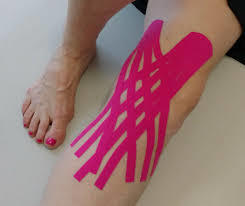
This blog applies to anyone with a swollen knee or sprained thumb. Most likely will be an athlete who recently got hurt while playing or practicing, however, these techniques can be used by anybody.
Now, if you're a volleyball athlete or basketball athlete, you'll probably be doing these two things more than others. The goal of the blog is to educate general populations on how easy it can be to tape your knee if swelling is present or to support your thumb if you sprain your thumb.
Two completely different things, however, as Sports Chiropractors who have worked numerous sporting events and have taped literally thousands of people, these are the most common (outside of ankle taping because that's too hard for most people).
Let's start with the swollen knee taping
The goal of using the Kinesio tape is to create an "octopus" to help with the lymphatic drainage of the swelling. What happens is the tape lifts the skin up which allows the lymphatic channels to flow better and helps decrease bruising and swelling to an extent. It's best used in acute swelling rather than chronic swelling but can be used for both.
As you can see in the video, the octopus head always goes towards the heart and the tentacles go towards the toes or fingers. You essentially cut 4 slits into the tape and apply minimal to no tension on the tape as you lay it over the affected area.
The tape will not provide support and has the sole purpose of reducing swelling. This can be applied anywhere, but for this specific example, we are using a swollen knee.
The tape can be left on for about 2-3 days, but if any redness or itchiness occurs, take the tape off.
At first, it seems like arts and crafts but once you get the cutting of the tape down, this becomes super easy and allows you to manage you or your youth athlete's swelling after a long tournament or practice.
Now, for the Thumb support taping.
If you've experienced a CMC sprain from a hyperextension or jam injury from a ball, this is the tape for you. The goal here is to provide rigid/flexible support to help keep the joint stable and reduce the risk of further injury. This is not magic, but can definitely get you through a long weekend if you've sprained your thumb.
As shown in the video, there is a combination of white athletic tape being used as well as flex-wrap of self-adhesive bandage.
The athletic tape is going to be much more rigid than the flex-wrap.
Either way, the goal is to create a "cancer bow" around the base of the thumb to help stabilize the joint. The easiest way to do that with white tape is to take a long strip and rip it right down the middle. This will create two skinny pieces of tape that can be used more easily to wrap around the base of the thumb.
It should be rigid enough to somewhat limit the range of motion of the thumb, however, it should not be so tight that your thumb turns white. That indeed means it is cutting off your circulation and will have to cut the tape off.
With the flex-wrap, you can perform the wrap in one continuous go-around, however, it takes a second to get used to how to angle the wrap. This would be much more flexible, however, with enough wrap you could make it quite rigid. This is a much simpler option for most, but if you've just hurt your thumb, this probably isn't rigid enough to protect the thumb.
The idea behind both of these tapings is to educate the athlete and/or parent to help them reduce the stress of pain or injury and make sure the athlete can be safe and recover. Little tips like this are taught in our office all the time to ensure our patients are educated and capable of managing their pain and injuries. Self-sufficiency is our goal for our patients.
Hopefully, these tape jobs help and if they do, please please please let us know so we can produce more content like this!
And if you're interested in being evaluated and treated further, you need to sign up for the free discovery visit on our website at strengthchiro.com
